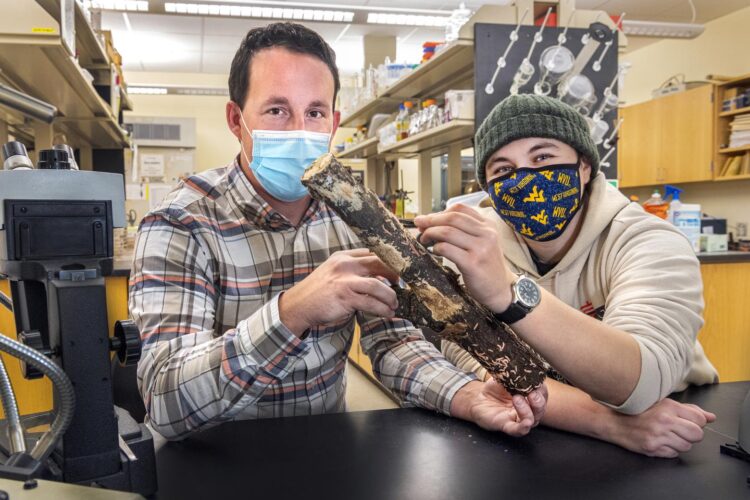
Credit: West Virginia University
Millipedes represent some of the earliest known terrestrial animals and are highly understudied, but two West Virginia University researchers are working to shine a light on these important invertebrates.
Several years ago, Matt Kasson and Angie Macias set out to better understand the association between the millipede Brachycybe lecontii and fungi, its life-sustaining food.
“Millipedes serve an important function in ecosystems. Most are detritivores, meaning they’re eating decomposing plant material that’s on the forest floor,” explained Kasson, associate professor of forest pathology and mycology in the Davis College of Agriculture, Natural Resources and Design. “But a certain group of millipedes about 250 million years ago diverged from those detritus-eating counterparts and started feeding exclusively on fungi.”
The tiny, pink and social Brachycybe lecontii is one of about 400 species of colobognathan millipedes to adopt the fungivorous lifestyle.
Their work, which represents the first investigation of the fungal associations for any of these millipedes and published last year in Fungal Ecology, uncovered tremendous fungal diversity.
“We found an incredible assortment of fungi, including representatives from some 176 genera and 40 orders, along with several undescribed species of fungi,” said Macias, a doctoral student in plant and soil sciences. “This elevated the animals from mere fungal foragers to biodiversity ‘hotspots.'”
Now, with the help of a biodiversity exploration and discovery grant from National Geographic, the pair plans to travel across the country documenting fungal diversity associated with half of the colobognathan millipedes that live in the United States.
“National Geographic funds innovative, cutting-edge scientific research and ideas,” Kasson said. “A lot of the stuff that gets funded oftentimes is in exotic locations and in understudied ecosystems that are hard to get to, but really make a nice story.”
In the time of a global pandemic when travel abroad is difficult and the future of research funding is unknown, the researchers believe the entirely domestic project and the intrigue of fungus-feeding millipedes worked to their benefit.
“Fortunately, Nat Geo saw that not only could we do the work safely, but that our questions were interesting and worth study,” Macias said. “It’s great to see a globally recognized organization validate our questions and agree to put forward the funds to make this groundbreaking basic-science happen.”
During 2021, a team consisting of Kasson, Macias and researchers from Michigan State University, University of California Riverside, Virginia Tech and William and Mary College, will embark on four collection trips to locations with confirmed colobognathan millipede sightings.
Locations include Arizona, California, parts of Appalachia including Logan County, West Virginia, southern Florida, Ohio, Pennsylvania and New York.
“We expect to describe for the first time the complete fungal communities of up to 25 fungus-feeding millipede species,” Kasson said. “In doing so, we intend to potentially uncover huge swaths of previously undescribed fungal biodiversity.”
It’s currently estimated that only 5% of the estimated 2.2 million species of fungi have been formally described.
“That leaves us in the dark for our understanding of diversity, ecology and the significance of fungi,” Macias said. “Every new fungus described is another step forward to closing that gap, and this project will be a leap forward for fungus-feeding millipedes and their fungi alike.”
###
Media Contact
Lindsay Willey
[email protected]
Original Source
https:/





